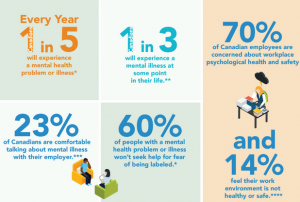This blog post was provided by Tanja Thani, MSW, who is a Special Projects Manager at Distress Centres of Greater Toronto.
At Distress Centres of Greater Toronto, a question we often receive from callers is, “how can I help someone in my life struggling with mental illness?”
If you’re like most people who can relate to this question, you know that often we want to be there for people we care about, but sometimes we do not know how to provide support. Supporting someone can be challenging, especially when we are afraid that we could make things worse, or when we don’t think we have the tools to help someone. Plus, it can sometimes feel uncomfortable to be there for someone you love when they are in pain.

Despite these challenges, know that there is a lot we can do that will not only effectively support those we care about while they are going through challenges, but we can also help prevent relapse. The best part about it is that we don’t need a degree in social work to do this.
Mental health affects us all.
According to the Government of Canada, 1 in 3 Canadians will experience mental illness or a substance use disorder in their lifetime.4
When Canadians reach the age of 40, 1 in 2 of us will have had or have mental illness,3 yet stigma and a lack of funding for resources across Canada is still an issue. When we look at suicide prevention, about 90% of those who died by suicide had a diagnosable mental illness.1 Now, let’s think about this. 1 in 3 of us will experience mental illness or a substance use disorder in our lifetime which sounds pretty common, right? Yet, when most of us experience mental health challenges, we feel isolated and alone.

You can help someone you love.
When supporting the people we love as they are experiencing mental health challenges, the first step is sometimes to challenge and change our own stigma towards these health challenges.
Mental health by definition is “a state of well-being in which the individual realizes their own abilities, can cope with the normal stresses of life, work productively and fruitfully and is able to make a contribution to their community.”5 Mental illness or mental disorders is “a recognized, medically diagnosed illness that results in significant impairment of an individual’s cognitive, affective or relational abilities.”5 This is a result from biological, developmental and/or psychosocial factors and can be managed, similar to physical diseases or disorders. 5
Why is mental health important?
If we look at mental health like we look at our physical health, then we will realize that our mental health is on a continuum. Our mental health changes over time, and these changes will depend on various factors such as social, biological, environmental, and other factors. The key takeaway here is that you can still have mental health with or without a mental illness or disorder. Think about it this way, could someone with asthma or diabetes still be considered healthy despite their diagnosis? The answer is yes. You can live with and treat these conditions, and mental illness or disorders are no different. The first step is to remove our bias and assumptions around mental illness or disorders and educate ourselves. You can continue to learn more about mental health and disorders by visiting the Canadian Mental Health Association (CMHA) or the Centre for Addiction and Mental Health (CAMH) which both have great resources on their websites.
While addressing our assumptions and knowledge around mental health and mental illness or disorders would be the first step to support loved ones who are experiencing mental health challenges, the following are other behaviours that we can use to support them:
- Connect with them on a personal level. People often feel alone when going through mental health challenges, so it is helpful that we reach out when someone is not well. You will want to build a rapport with them by building trust and a safe space so they feel comfortable talking to you. This means putting our judgment aside, using a warm tone when speaking, and allowing people to say what they feel comfortable with. Mainly, you want to empathize how they are feeling which involves perspective taking, non judgment, understanding another person’s feelings, communicating your understanding of these feelings, being present, and not judging how they feel.2 All we have to do is imagine what the person is feeling and imagine yourself in their shoes.
- Find out about what they are experiencing. Ask what they are experiencing to open up a conversation and get a sense of what they are going through. Remember, it’s important not to force this. Some people need more time before they can tell you what they are going through and if that’s the case, that’s okay. They will at least know that you are open, interested in learning about their experience, and want to be there for them.
- Ask what they need. It’s as simple as that. The kind of support they need from you or others will vary and it’s important to listen.
- Collaborate on options and solutions. Instead of jumping into telling them how they can solve their problems, first ask what they have tried to address the situation. Build on their strengths and find out what they see as options. Remember that their strengths are still there regardless of what is happening, so it’s an opportunity to build on that.
- Empower them. When we are going through challenges, we sometimes feel helpless or hopeless. Encourage them to continue to try, compliment them of their strengths, and remind them that the way they feel isn’t permanent and there is hope.
- Address harm reduction. Sometimes when we are going through a tough time, we start coping in ways that can be harmful. This can include excessive drinking, drug use, or physical self harm. If you see concerning behaviour or habits, you will want to have a conversation with them about it and see if there are ways to increase safety. For example, drinking with others and setting a limit of how many drinks you have. You want to brainstorm options with them, let them know that you care, and approach this compassionately because they are using this behaviour to help themselves get through their pain. If they do not see this as an issue at first, that’s okay. At least you began a dialogue and that is the first step.
- Provide useful resources. Oftentimes someone struggling won’t know where to turn for help, and it can be beneficial for you to offer support by researching places or resources they can turn to for professional assistance. This could involve encouraging them to see their family doctor to get a referral to a mental health professional. Or if you are concerned about a young person, connect them with Kids Help Phone in case they need to talk.
There are so many ways to support someone living with mental health challenges and know you are not alone in supporting someone who is going through this. At Distress Centres of Greater Toronto, we do this every day and we know that just connecting and empathizing with someone is healing. If you need more suggestions or tips, feel free to call our 24/7 services at 416-408-4357 as we are here not only to support your loved ones, but you as well.
Learn more and make a donation in support of the Distress Centres of Greater Toronto today.
References:
- Bertolote, J.M. & Fleischmann, A. (2002). Suicide and psychiatric diagnosis: a worldwide perspective. World Psychiatry. 1(3), 181-185. Retrieved from https://www.ncbi.nlm.nih.gov/pmc/articles/PMC1489848/
- Brown, Brené. (2018). Dare to Lead. New York, NY: Penguin Random House LLC.
- CAMH. (undated). Mental Illness and Addiction: Facts and Statistics. Retrieved from https://www.camh.ca/en/driving-change/the-crisis-is-real/mental-health-statistics
- Office of the Ombudsman for Mental Health. (2017, September). First Report to the Deputy Minister. Retrieved from https://www.tpsgc-pwgsc.gc.ca/osm-omh/documents/osm-omh-rapport-report-eng.pdf
- Workplace Mental Health Promotion. (2017). What is Mental Health and Mental Illness? Retrieved from http://wmhp.cmhaontario.ca/workplace-mental-health-core-concepts- issues/what-is-mental-health-and-mental-illness#_ftn1
Leave a Reply